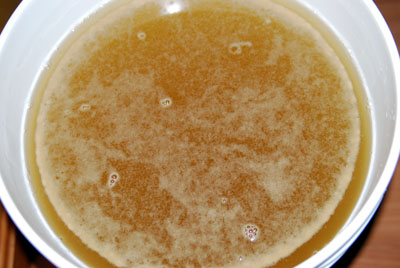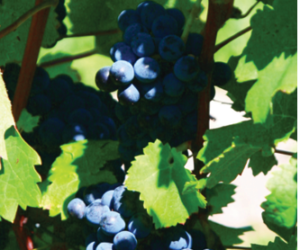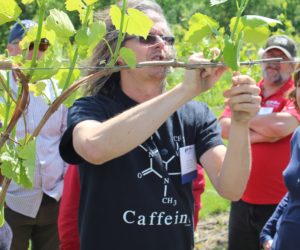 For more than 10 years I have been a home winemaker and for almost that long I have also brewed beer. Before that, I was general manager at a company that sells wine production products — including yeast — to commercial wineries. Through all that time, two facts about yeast most impressed me. First, what yeast does for alcoholic beverages is a miracle: (sugar) water into wine. Second, human attitudes and uses of yeast are stronger influences than the nature of the organism itself. That is, brewers, bakers and winemakers have very different approaches to using yeast, even though they happily employ microbes of the same genus and species. In line with this 15th anniversary issue of WineMaker, let’s review 15 things to know about yeast.
For more than 10 years I have been a home winemaker and for almost that long I have also brewed beer. Before that, I was general manager at a company that sells wine production products — including yeast — to commercial wineries. Through all that time, two facts about yeast most impressed me. First, what yeast does for alcoholic beverages is a miracle: (sugar) water into wine. Second, human attitudes and uses of yeast are stronger influences than the nature of the organism itself. That is, brewers, bakers and winemakers have very different approaches to using yeast, even though they happily employ microbes of the same genus and species. In line with this 15th anniversary issue of WineMaker, let’s review 15 things to know about yeast.
History
1. Human use of yeast is ancient.
The word first appeared in English in the 12th century, long before anyone knew anything about microbiology. “Yeast” derives from Middle English “yest” and the Old English “gest”; all ultimately from Greek “zein”: to boil. Yeast has been used for fermentation for so long that we may well consider it the first domesticated organism in human history. As far back as the second century BC, Cato the Elder was writing winemaking advice that included stirring the yeast lees to improve wine quality.
2. Yeast choice is important.
As an owner of a home fermentation hobby store, I often see more passion about the effects of yeast among homebrewers than I do among many home winemakers. Every brewer knows that a German Hefeweizen strain of yeast will produce clove and banana aromas that would be completely inappropriate in a Czech Pilsner, and there is an entire book on yeast directed at homebrewers. In the winemaking literature, though, some authors downplay the significance of this very important choice, asserting that any differences in wine as a result of yeast choice will disappear over time. In this case, I whole-heartedly share the popular brewer’s view: yeast choice counts.
3. Yeast is employed in all manner of products for human use and enjoyment.
Mead, or honey wine, may well be the oldest fermented beverage of them all. Distilled spirits, from the sugar cane of rum to the potatoes of Polish vodka, are first fermented with yeast. Either starting with sugar, or using some process to convert starch to sugar, the yeast makes the alcohol before the distiller turns it into high-proof. Even industrial ethanol for blending with gasoline gets its start as a yeast fermentation. On the food side, of course, there is bread. Here, instead of utilizing the ethanol that yeast produces, bakers use the carbon dioxide to produce bubbles in the dough; leavening the bread. Evidence suggests that natural “wild” yeast may have leavened bread as long ago as 10,000 years. Finally, sometimes with the help of genetic engineering, yeast is put to work producing antibiotics and other drugs.
4. Louis Pasteur changed the world’s understanding of fermentation.
The “germ theory of disease,” in which we ascribe the origin of many illnesses to the introduction and growth of pathogenic organisms, was in its infancy at the time of Pasteur in the mid-nineteenth century. Prevailing thought still favored “spontaneous generation” or the sudden development of disease without a specific causative agent. As far back as the seventeenth century, Van Leeuwenhoek used his microscope to observe yeast cells in beer. But it was up to Pasteur to put it all together. He demonstrated that yeast ferments sugar to alcohol, and can do so under anaerobic conditions. In 1863, Napoléon III commissioned him to study problems with French wine. In 1866, he published “Studies on Wine” discussing the benefits of yeast fermentation, the risks of bacterial spoilage, and beneficial techniques for stabilizing wine.
5. “Wild” vs. “cultured.”
In the beginning, all yeast was “wild.” That is, grape must turned to wine (if it did at all) through the action of yeast that came into the winery on the grapes, fell into the must from the air, or was already present on winemaking equipment. Much later, pioneers like Anton Dreher came to realize that repeating exactly the same fermented product (in his case, lager beer) depended upon maintaining a healthy supply of exactly the same yeast strain. Dreher’s new style of beer was so popular that other brewers obtained samples of it and helped develop the world-wide dominance of lager beers into the twentieth century. This approach may be characterized as among the examples where a wild yeast is first captured in a spontaneous fermentation (with the organism delivered to the sugar water from somewhere), and then deliberately cultured and developed for its desirable characteristics. Today, many winemakers still prefer to use “wild” yeast and take their chances with the outcome. Many others, however, use cultured yeast which, propagated from its natural origins, has known and desirable characteristics. When wine yeast production companies are asked to carry out DNA analysis on “wild” ferments that have produced good wine, they often find that the yeast strain is one already in commercial production.
Physiology
6. Lots of species.
So far, the discussion has been about yeast in general. That is, a unicellular fungus with particular emphasis on those that consume sugars, producing alcohol and carbon dioxide. For the heavy lifting in most wines, we are talking about the genus and species Saccharomyces cerevisiae. There are, however, many more than that out there, with over 1,000 species described. Grapes arriving from the vineyard may well carry yeasts from different genera than Saccharomyces; various Candida and Kloeckera are common and may cause spoilage if allowed to grow. Even within the Saccharomyces genus, yeasts from more than one species may be found useful in fermentation. Some wine yeasts are S. uvarum, often selected for resistance to alcohol.
7. Reproduction.
Most yeasts (and all that are used for commercial beverage production) reproduce by budding; a yeast cell produces a “bud,” growing on its surface. The cell nucleus makes a copy of itself, which migrates into the bud, which then splits off. This vegetative or asexual reproduction is what happens during the active growth in a fermenting beverage.
8. Growth.
The recommended inoculation rate for wine yeast is about one gram per gallon (or two pounds per thousand gallons). That produces a cell concentration of about one million (106) per milliliter. Wine undergoes a lag phase of a few days while the yeast becomes acclimated to the must and the population grows only a little. After that, yeast enters an exponential growth phase, with the concentration rising to about 108 per milliliter; a hundred-fold increase. Sugar levels drop dramatically and alcohol concentration rises. After this period, the yeast enters a few days of stationary phase, where the cell concentration remains relatively constant, toxic byproducts (including alcohol) build up, and sugar is depleted. The yeast then enters a decline stage, where the population goes dormant and drops out of solution and fermentation is over.
9. Aerobic vs. anaerobic.
Yeast is a “facultative” organism: It can grow in the presence of oxygen (aerobically) or without it (anaerobically). As a result, the yeast producers who grow wine yeast commercially have a different outlook than the winemakers who use it. Yeast grows most rapidly and vigorously when well aerated — but it doesn’t accumulate alcohol while doing so. During the rapid growth phase in a wine fermentation, conditions are anaerobic because O2 is rapidly depleted by yeast during the early stages of active fermentation as it is needed for cell growth. The carbon dioxide given off by the yeast then scrubs out any oxygen that enters the fermenter from the air — and alcohol accumulates. Red fermentations gain some oxygen from pumpovers or punchdowns, but the beneficial effects on yeast growth occur primarily in the first few days. Those who sell yeast use lots of oxygen, those who use yeast admit only a little.
10. Nutrition.
Yeast derives energy from carbon primarily in the form of hexoses (six-carbon sugars), like the glucose and fructose in grape juice. It grows best in a neutral or slightly acidic environment. To remain healthy, other nutrients are needed, including zinc, phosphorus, magnesium, potassium, and nitrogen. In grape must, all but nitrogen are almost always present in sufficient concentrations. Yeast utilizes nitrogen in the form of ammonia or primary amino nitrogen. The former can be supplemented using simple salts such as diammonium phosphate, while the latter is introduced with yeast-based preparations such as Fermaid-K or Superfood. Using the more complex nutrients may also make up for any lack of vitamins or trace minerals the yeast may need.
11. Strain selection.
Within S. cerevisiae, there are many different variants or strains available to the winemaker. Just as every dog in the show is Canis lupus familiaris, the wine yeast genus and species can encompass differences as profound as Chihuahua and St. Bernard. After culturing a successful wild-caught yeast in the laboratory, a yeast producer will try it out on a small scale with volunteer winemakers. They look at vigor, alcohol tolerance, nutritional needs and sensory effects on the wine. When conditions look favorable, the yeast strain is produced in commercial quantities and its characteristics are published.
Fermentation effects
12. Aroma.
Yeast influences wine aromas in two fundamental ways. The first is direct production by the yeast of a wide range of aroma compounds, primarily esters. These comprise many of the more than 300 aroma compounds that have been identified in wine, illustrating the complex fruitiness we encounter in our favorite beverage. The second group of esters comes from the grapes themselves, but they are often in a form that is not volatile and therefore cannot be smelled. Some strains of yeast can release these esters and other aroma compounds into the wine during fermentation, enhancing the final product.
13. Mouthfeel.
We all want body and richness in the mouthfeel of our wines, avoiding thin or watery effects. The tannin profile of the wine is by far the biggest influence on mouthfeel, but yeast may have a small role to play. At least one major supplier of commercial wine yeast asserts that higher glycerol production by some strains can contribute additional fullness and smoothness to a wine.
14. Color.
Ultimately, color in red wine comes from the skin of the grapes. Anyone who has looked at pomace after pressing or lees after racking knows that a great deal of grapeskin pigment is left behind in winemaking. Several strains of yeast are reported to enhance the extraction and stability of color. Some yeasts produce higher concentrations of enzymes capable of releasing pigments from the skin cells of the grapes (improved maceration). In addition, research has shown differences in pigment binding to yeast biomass, possibly leading to differences in color loss during and after fermentation. Differences in finished wines resulting from this effect may be noticeable in lighter styles of red wine.
15. Yeast-caused defects.
The two most prominent wine problems caused by yeast come from very different sources. Any yeast strain that suffers a deficiency in nitrogen nutrition may produce hydrogen sulfide — the dreaded rotten egg stink. Strains that are particularly susceptible to this problem are identified by the producers as being high in nutrient demand. On the other hand, a completely different genus of yeast — Brettanomyces — causes aroma problems all by itself. Most American producers eschew even a hint of the barnyard, plastic bandage, or sweaty horse aromas these yeasts produce. Since the specific compounds Brettanomyces introduces — 4-ethylphenol and 4-ethylguaiacol — cannot be removed by a home winemaker after the wine is finished, you must avoid the yeast itself.







